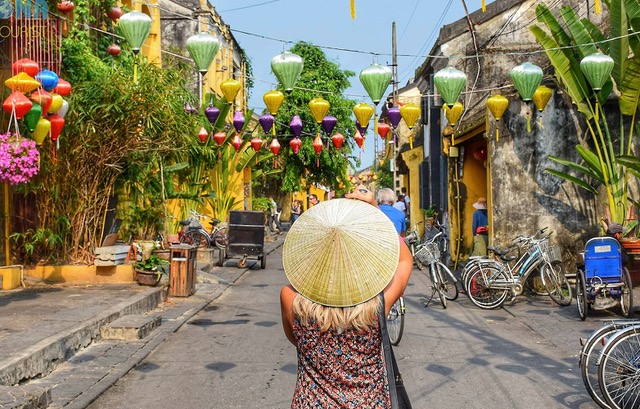Hoi An, Vietnam: A Tale of Ancient Trade and Modern Tourism
Hoi An stands as a testament to the resilience of Vietnamese heritage and a cherished destination
2/6/2024

Nestled along the serene Thu Bon River in central Vietnam lies the enchanting town of Hoi An, a place steeped in history and culture. Its story stretches back centuries, intertwined with the rise and fall of empires, the ebb and flow of trade, and the enduring spirit of its people. Today, Hoi An stands as a testament to the resilience of Vietnamese heritage and a cherished destination for travelers from around the world.
Ancient Origins and Connection with the Cham Kingdom
The history of Hoi An dates back over two millennia, with its origins rooted in the ancient Champa Kingdom. Established by the Cham people around the 2nd century AD, the kingdom flourished along the central and southern coast of present-day Vietnam. Hoi An, known then as Lam Ap Pho, served as a bustling port city, linking the Cham capital of Indrapura (near present-day Da Nang) to distant lands across the seas. The Cham people were skilled seafarers and traders, navigating the waters of the South China Sea to engage in commerce with neighboring kingdoms and empires such as China, India, and Java. Hoi An emerged as a vital hub for the exchange of goods, ideas, and cultures, facilitating the flow of silk, spices, ceramics, and precious metals.
The Rise of Hoi An as an International Port
In the 16th and 17th centuries, Hoi An experienced a golden age of trade under the rule of the Nguyen lords and later the Nguyen dynasty. The town's strategic location at the mouth of the Thu Bon River enabled it to thrive as a major port along the maritime Silk Road, attracting merchants from Europe, Japan, China, and Southeast Asia.Foreign traders established flourishing communities in Hoi An, each leaving their mark on the town's architecture, customs, and cuisine. Chinese merchants built ornate assembly halls and temples, while Japanese traders constructed the iconic Japanese Covered Bridge, a symbol of their presence in the town. European influence also left its imprint, evident in the colonial-style buildings and trading houses that still line the streets of the Old Town.
Decline and Resurgence
By the 18th century, Hoi An's prominence as a trading hub began to wane, as nearby Da Nang emerged as a more accessible port. The Thu Bon River silted up, restricting access for larger vessels, and political upheavals further disrupted trade routes. Hoi An gradually faded into obscurity, its once-thriving port overtaken by the march of time. However, the town's rich cultural heritage and well-preserved architecture remained untouched, hidden from the outside world for centuries. It wasn't until the late 20th century that Hoi An reemerged as a tourist destination, drawing visitors with its atmospheric streets, vibrant markets, and timeless charm.
Hoi An Today
A Treasured Tourist AttractionIn 1999, UNESCO recognized Hoi An's cultural significance by designating it a World Heritage Site. The designation helped to safeguard the town's architectural heritage and spurred investment in conservation efforts, ensuring that future generations could experience its unique beauty. Today, Hoi An is a magnet for travelers seeking an authentic glimpse into Vietnam's past. The Old Town, with its narrow lanes and weather-worn buildings, transports visitors back in time to the heyday of the trading port.
Traditional wooden houses adorned with intricate carvings stand alongside Chinese temples and French colonial villas, creating a captivating blend of architectural styles.The town's culinary scene is equally enticing, with an array of street food stalls, family-run eateries, and upscale restaurants offering a taste of Vietnamese cuisine. From fragrant noodle soups to fresh seafood delicacies, Hoi An delights the senses with its diverse flavors and culinary traditions.
Beyond its historical allure, Hoi An also offers opportunities for cultural immersion and exploration. Visitors can partake in hands-on activities such as lantern-making workshops, traditional cooking classes, and boat rides along the Thu Bon River. The town's monthly Full Moon Lantern Festival, known as "Hoi An Ancient Town Night," is a spectacle not to be missed, with streets illuminated by thousands of colorful lanterns and traditional performances filling the air with music and dance.
As tourism continues to grow, Hoi An faces the challenge of balancing preservation with development. Efforts are underway to manage visitor numbers, protect the environment, and sustain the town's unique character for future generations. Through responsible tourism practices and community engagement, Hoi An strives to preserve its legacy as a cultural gem and ensure that its story continues to captivate and inspire all who wander its ancient streets.
Since 1989, First Cabin Travel has offered luxury-styled itineraries to unique and varied destinations with the majority of bookings derived from repeat clientele and their enthusiastic referrals.
First Cabin is your passport to excellence
CA Reg: 2018168-40






